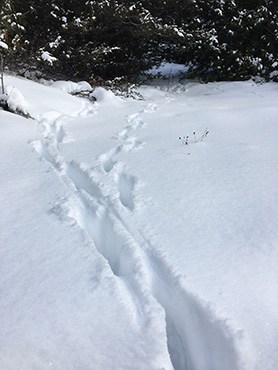Here is a true story that happened during one of my winter walks. Who knows what you might discover?
 I once noticed a doe who was wandering the woods. She was tired and nursed an injured right hind leg. She lay down in a thicket of bushes until she heard some coyotes. She began to run but unfortunately she was not quick enough. I discovered this story as it was written in the powdery snow of a conservation area. I did not see the deer alive.
I once noticed a doe who was wandering the woods. She was tired and nursed an injured right hind leg. She lay down in a thicket of bushes until she heard some coyotes. She began to run but unfortunately she was not quick enough. I discovered this story as it was written in the powdery snow of a conservation area. I did not see the deer alive.
Reading a track is like learning to read a story. We can all read and write. And you can also learn to read tracks as they are written in the soft snow of our nearby natural areas. The story may be written in a different kind of language but every tale can be just as compelling those we find in books. It just involves a different kind of language. All it takes is a combination of some experience and common sense.
Let us think about the doe. I knew the doe was tired because her tracks wandered and her feet dragged considerably more than other deer tracks I had spotted that day. I knew her hind leg was injured because it registered a longer drag mark than her other feet and it was the last foot to show up in the track. I also spotted a few drops of blood. I saw clearly where she lay down in the thicket.
Her stride began to lengthen immediately after she had found a spot to bed down. I knew from the tracks that began to chase her that these were probably coyotes in pursuit. I also knew that wolves are more often seen up north. Coyotes also show direct register when they walk. My suspicions were confirmed when I discovered the carcass of the deer. It had been eaten from the hind quarters first. Wolves usually start from the head. Wild dogs often make a kill but they do not often consume the whole carcass.
As a way to practice reading tracks try this simple activity. You’ll need yourself and few eager participants. If you can, find an area that has fresh snow. Ask your group to stand in a straight line with their back to you. Make sure there is undisturbed snow behind them. As a way to distract your group and to disguise the noise you make, have them sing a song in unison. Now, right behind your group’s backs, make a tracking pattern. Here are some suggestions:
Jump with two feet,
Walk on all fours
Lay in the snow,
Walk normally then run,
Hop on one foot.
Turn around and walk backwards
When you have a clear track, have your group pivot in the same spot and study the story you’ve just made. Don’t forget to remind your group that their feet are just like big erasers, able to wipe out your freshly made tracks. Can they tell you what happened? Here are some questions your group can try to answer for any track they encounter. Use your tracking story as a guide.
- Which way was I going? Examine the scuff marks. Often a small and discernible scuff mark will appear at the rear of a track. While this isn’t a hard and fast rule, it does help to establish the direction of travel.
- How far apart are my tracks? Most animals have a “harmonic gate” – this the normal speed at which they travel. When an animal runs, its stride (or the distance between tracks) increases.
- What was I doing? During the day, white-tailed deer will often rest at the side of a hill. Sometimes you can spot the area where it has laid down (called a bed).
- What pattern do my tracks have? This is often a clue as to what kind of animal it is. For example rabbits hop with their two back legs beside each other and the front feet landing


